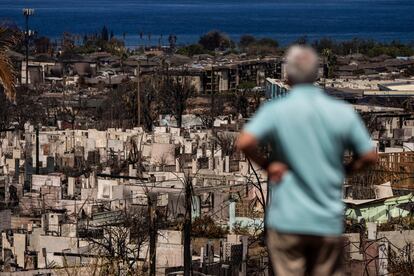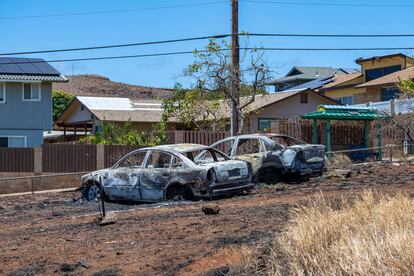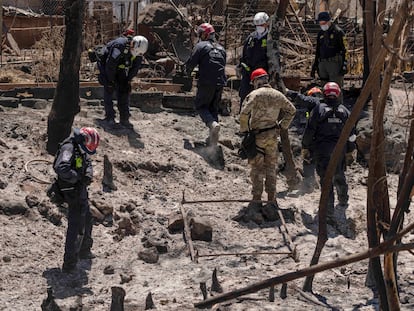Maui wildfire: After the blaze, the fury and the pain
Lahaina residents are demanding explanations for the perceived mismanagement of the disaster. ‘All because the so-called alarms didn’t go off,’ says one resident whose house was reduced to ashes


“Missing. Any leads would be appreciated.” “Have you seen these people? Please call us.” The photocopied posters on the wall of Lahaina’s evacuee aid center are a succession of cries for help. Eleven days have passed since the wildfire, which left at least 114 dead and devastated this city — the economic and cultural center of the Hawaiian island of Maui — and the search for missing people and bodies continues. Meanwhile, as they come to terms with the pain and the extent of the devastation, the survivors are demanding explanations for a disaster management that has raised many questions.
The deadliest wildfire in more than a century in the U.S. started Tuesday, August 8, on a mountainside above Lahaina and spread at lightning speed, fueled by winds from a distant hurricane that reached 80 mph. The viciousness of the flames took much of the 12,000-strong population by surprise as they grappled with the loss of any cellphone service and electricity. Many fled, armed with the bare essentials or nothing at all, to find a long traffic jam on the only road out of town still open. Dozens of people threw themselves into the sea in a bid to escape. Others remained trapped.
The cause of the fire has yet to be established. An independent investigation points to sparks from electricity poles knocked down by the high winds. Residents also point to the lack of water pressure in the fire hydrants, which experts attribute to pipes damaged by the fire. And, above all, the residents are angry that the emergency sirens did not sound.
“They say the way to warn us was landlines,” says Kim Camacho, a kindergarten teacher at Princess Nahi’ena’ena School. “How many of us have a landline? Unless you have a business, nobody has landlines anymore. They also mention cellphones. But we had been without power all day. Our cellphones were dead and there was no service either. The only way we could have known about the danger was through those emergency sirens.”
Like most Lahaina residents, Camacho had to escape in a hurry. By the time she was able to return, her home had been reduced to a carpet of ashes, her possessions reduced to her car and what fit in one suitcase. “I didn’t notice the fire until I had the police in my driveway,” she says. “I drove the car around the block and saw everything was on fire. And all because those damn sirens didn’t go off,” she adds as she comforts one of her students, whose family has also lost everything.
Camacho acknowledges that the windstorm also had a role to play. “When there’s a storm and the power goes out, we’re used to just sleeping it out,” she says. “You can’t go out, so what else are you going to do? My neighbor two houses down escaped by the skin of her teeth. If the police hadn’t come to warn her, she wouldn’t have known about it.”
Herman Andaya, the recently resigned head of Maui’s Civil Protection, tried last week to justify the decision not to activate the sirens. He argued that the sirens are intended to warn of possible tsunamis. Setting them off could have caused residents to flee towards the mountain, in the direction of the fire, he said, an explanation that has triggered fury among Lahaina residents: “Climbing up the mountain, and getting out from there, was the only way to escape!” says Camacho.
“Do you think we’re so stupid we would run into the fire?” says Keki Keahi, a member of a coalition calling for resident participation in Lahaina’s rebuilding plans. “We’re a little smarter than that. We have hurricanes, we have tsunamis and we have sirens, but we already knew the hillside was burning.”
Besides the failure to sound the sirens, some residents have pointed out that the police had erected barriers across the roads in and out of Lahaina and were directing drivers towards the boardwalk, which had collapsed. The remains of that street, as well as others around it, are still littered with charred vehicles.

“I don’t know what caused every access to be blocked,” Maui Mayor Richard Bissen said to reporters during a visit to the evacuee aid center on August 18. “Our fire department lost a vehicle in the fire. They were fighting the fire and were surrounded. Other vehicles also caught fire. People got out of their cars and fled. I don’t think there was a single cause for blocking access.”
Hawaii Attorney General Anne Lopez has announced the opening of an “impartial and independent” investigation into the actions of government agencies in preventing and managing the disaster.
Questionable infrastructure
Also in question is the role of the Hawaiian Electric Company, which is being sued by user groups on Maui for negligence and alleged responsibility for the fire. The plaintiffs accuse Hawaiian Electric of failing to shut off power despite warnings that winds from Hurricane Dora could knock down poles and wires and cause fires.
A video shot by a Lahaina resident shows how a collapsed wire caused dry grass next to a road on the outskirts of town to start burning. An independent firm that examines power grid sensors reported dozens of power cuts in the hours leading up to the fire, the fault of one such cut being captured on video as a loud spark on the power line.
The company has pledged to assist Lopez’s investigation and said it will examine whether its infrastructure may have played a role in the disaster. According to the governor of Hawaii, Josh Green, it will take “years” and “billions of dollars” before Lahaina is restored to its former glory. Hawaii Electric’s CEO, Sheely Kimura, said that the company does not have a system to shut off the electricity supply in the event of a natural disaster or high winds: “In Lahaina, the pumps that supply water are powered by electricity,” she said at a press conference. “There was an absolute necessity for power at that time.”
But the utility was already aware that its infrastructure posed risks. In a statement to the public utilities commission last year, it proposed replacing old poles with ones that would better withstand the force of the wind, as well as trimming the surrounding vegetation, although it estimated that the replacement would take years to complete. The document listed Lahaina as a priority area. The firm’s stock has fallen 49% this week, and ratings firm Standard and Poor’s has downgraded its credit to junk bond status.
The lack of electricity and cellphone service in the days following the fire has also made it difficult to determine how many people are still missing. Without proper communications, many of those who escaped were recorded on different lists, each containing hundreds of names. Some officials put the number of people unaccounted for at around 1,000. The relief services are now trying to crosscheck and update these lists.
At the evacuee aid center, Camacho says, “When I came here to teach school, all I had was a car and a suitcase. All these years later, what do I have? A car and a suitcase. We’re going to be fine, you’ll see. We’ll get through this. We did it once and we’ll do it again.”
Sign up for our weekly newsletter to get more English-language news coverage from EL PAÍS USA Edition
Tu suscripción se está usando en otro dispositivo
¿Quieres añadir otro usuario a tu suscripción?
Si continúas leyendo en este dispositivo, no se podrá leer en el otro.
FlechaTu suscripción se está usando en otro dispositivo y solo puedes acceder a EL PAÍS desde un dispositivo a la vez.
Si quieres compartir tu cuenta, cambia tu suscripción a la modalidad Premium, así podrás añadir otro usuario. Cada uno accederá con su propia cuenta de email, lo que os permitirá personalizar vuestra experiencia en EL PAÍS.
¿Tienes una suscripción de empresa? Accede aquí para contratar más cuentas.
En el caso de no saber quién está usando tu cuenta, te recomendamos cambiar tu contraseña aquí.
Si decides continuar compartiendo tu cuenta, este mensaje se mostrará en tu dispositivo y en el de la otra persona que está usando tu cuenta de forma indefinida, afectando a tu experiencia de lectura. Puedes consultar aquí los términos y condiciones de la suscripción digital.
More information
Archived In
Últimas noticias
Most viewed
- Sinaloa Cartel war is taking its toll on Los Chapitos
- Oona Chaplin: ‘I told James Cameron that I was living in a treehouse and starting a permaculture project with a friend’
- Reinhard Genzel, Nobel laureate in physics: ‘One-minute videos will never give you the truth’
- Why the price of coffee has skyrocketed: from Brazilian plantations to specialty coffee houses
- Silver prices are going crazy: This is what’s fueling the rally










































